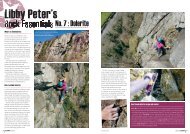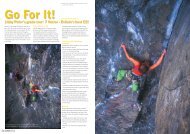You also want an ePaper? Increase the reach of your titles
YUMPU automatically turns print PDFs into web optimized ePapers that Google loves.
Caption<br />
141-36<br />
<strong>No</strong>. 4 : <strong>Granite</strong><br />
Ruth Taylor on South Face Direct (VS 4c),<br />
Chair Ladder, Cornwall.<br />
All photography: Mike Robertson<br />
How granite is formed<br />
............................<br />
<strong>Granite</strong> is an igneous rock originating from<br />
the slow crystallisation of molten magma<br />
cooling deep beneath the Earth’s surface.<br />
It forms great pillow accumulations called<br />
batholiths, which once uplifted and exposed,<br />
create great undulating plateaus punctuated<br />
by the sheer cliffs carved by glaciation. The<br />
word ‘granite’ is derived from the Latin<br />
granum, meaning grain and describes the<br />
granular texture of the rock. <strong>Granite</strong> always<br />
consists of the minerals feldspar and quartz,<br />
which give granite a light colour ranging from<br />
pinkish to white. But that light background<br />
colour is peppered with darker accessory<br />
minerals, such as the black mica – biotite and<br />
the black amphibole – hornblende.<br />
<strong>Granite</strong> is a strong rock because its mineral<br />
grains have been knitted tightly together<br />
during a very slow cooling period and the<br />
quartz and feldspar that compose it are<br />
harder than steel. It’s highly resistant to<br />
weathering and acid rain so it’s no surprise<br />
that granite is used widely in buildings and<br />
more importantly, makes such awesome cliffs.<br />
Geographical spread<br />
............................<br />
To find the best granite you should travel<br />
to either end of the country. The tip of<br />
Cornwall has exquisite granite cliffs, plunging<br />
dramatically into the restless Atlantic.<br />
The settings are beautiful and the rock<br />
immaculately clean. Several hundred miles<br />
to the <strong>No</strong>rth, in the Highlands of Scotland,<br />
there are world-class crags in abundance;<br />
the Loch Avon (pronounced A’an) basin,<br />
in the heart of the Cairngorms is one of<br />
the most magical places you’ll ever climb<br />
(summer or winter). The glacially gouged<br />
loch plunges deep into the heart of the<br />
granite massif, giving a focal point and<br />
grandeur to the five separate big granite<br />
cliffs that overlook the head of the loch,<br />
each one with a clutch of classics to work<br />
your way through.<br />
The other main granite areas in the UK<br />
are Dartmoor, where the uniquely weathered<br />
tors sit proudly amidst a wild and windswept<br />
landscape, and the Mourne mountains in the<br />
South East of <strong>No</strong>rthern Ireland, which boast<br />
over a thousand routes on 20 separate crags<br />
with every grade covered.<br />
Photo: Rich Mayfield.<br />
Worldwide, granite geology provides us<br />
with some of our most inspiring rock walls<br />
and climbing arenas. The Yosemite Valley<br />
in California is perhaps the most famous<br />
of all with the 3000ft El Capitan and the<br />
distinctively carved Half Dome.<br />
How to climb it<br />
............................<br />
Climbing on granite for the first time<br />
can be a humbling experience. The great<br />
sweeps of rock, whether slabby or steep,<br />
are often devoid of obvious looking holds<br />
and the moves can be hard to read.<br />
Though much of the time you’re climbing<br />
in-balance, there are frequent unusual<br />
moves that require ingenuity and above all<br />
else, confidence.<br />
<strong>Granite</strong> slabs are notoriously sustained,<br />
with move after move identical to the last.<br />
Though the friction is good, it’s often hard<br />
to trust it and the prospect of the long<br />
grating slither undermines confidence and<br />
good technique.<br />
Many steeper cliffs and tors have<br />
characteristic deep horizontal weathered<br />
cracks and breaks with rounded edges,<br />
requiring big open handed moves that<br />
once again respond best to a confident<br />
approach. These are coupled with vertical<br />
cracks that are, more often than not,<br />
wider than you’d like. The climbing is<br />
physical and often inelegant.<br />
26<br />
05|09<br />
climber.co.uk 05|09 27
Caption<br />
<br />
How to place gear in granite<br />
............................<br />
We don’t bolt granite (very much) in this<br />
country so you need a standard rack plus<br />
the addition of both micro gear and big<br />
pieces. <strong>Granite</strong> crack systems come in all<br />
sizes, from tiny seams to off-width. You’ll use<br />
everything from the tiniest micro wires in<br />
Big cam!<br />
vague widenings in the seams, to the biggest<br />
cams you can carry (4s and even 5s). Cams<br />
do work wonders in granite but be wary of<br />
cams sitting against crystals inside cracks.<br />
These same crystals may also prevent nuts<br />
from seating fully.<br />
Special features and<br />
particular hazards<br />
............................<br />
Tors are a wonder of granite. Though they<br />
are rarely higher than 10-15m, these natural<br />
hilltop crags sculpted by years of weathering<br />
produce intriguing climbs.<br />
Feldspar knobs are perfectly engineered<br />
hand and footholds protruding from<br />
otherwise smooth granite faces. There’s a<br />
particularly memorable knob pitch on the<br />
evocatively named Lotus Flower Tower, above<br />
the Fairy Meadows in <strong>No</strong>rth West Canada’s<br />
Cirque of the Unclimbables.<br />
<strong>Granite</strong>’s rough ‘cheese grater’ texture is<br />
legendary; wearing shorts and granite lobs<br />
just don’t mix.<br />
The sustained nature of many granite<br />
pitches, both slabs and cracks, is exhausting.<br />
The off-width ‘stove-leg’ cracks on El Cap’s<br />
The <strong>No</strong>se are a good example.<br />
Best loved crags and routes<br />
............................<br />
The Cairngorms in Scotland is without doubt<br />
THE place to go for granite. In the Loch A’an<br />
basin you’ll find something for every occasion.<br />
Afterthought Arête is a delightful Mod on Stag<br />
Rocks, Auld Nick is a great Severe on Hell’s<br />
Lum and The Needle (E1 5b) on Shelter<br />
Stone is excellent, but The Steeple (E2 5c) on<br />
the same cliff, is without doubt one of the best<br />
E2s in the country.<br />
The <strong>No</strong>rthern Corries, though less remote<br />
have some great climbs dotted amongst the<br />
looser sections of cliff. Magic Crack (HVS 5a)<br />
in Coire an t-Sneachda, and Savage Slit (VD) in<br />
Coire an Lochain are both 3 star quality.<br />
For remoteness seek out Squareface (VD)<br />
and Mitre Ridge (HS) on Beinn a’ Bhuird.<br />
Then make the trek to Creag an Dubh-loch<br />
where there’s at least a lifetime’s climbing,<br />
Black Mamba (VS 4c) is a good place to start.<br />
And while you’re over there nip up Eagle<br />
Ridge (S) on Lochnagar – it’s brilliant.<br />
The Etive (Trilleachan) Slabs near Glen<br />
Coe are uniquely sculpted and uniquely<br />
terrifying. Get a feel for it on Spartan Slab<br />
(VS 4c). If that goes well get on Hammer<br />
(HVS 5a) and if you haven’t terrified yourself<br />
enough take a look at Swastika (E2 5c).<br />
Mike Robertson high on Snake Dyke<br />
(5.7R), Half Dome, Yosemite, California.<br />
Photo: Will Jones.<br />
Cornwall: Sennen, Bosigran and Chair<br />
Ladder are all world-class crags with umpteen<br />
classics to their credit. Demo Route (HS) on<br />
Sennen is a must-do, as is Doorpost (HS) on<br />
Bosigran, Terrier’s Tooth (HS 4b), South Face<br />
Direct (VS 4c) and Bishops Rib (E1 5b) on<br />
Chair Ladder are all faultless.<br />
Dartmoor’s Hay Tor and Low Man are<br />
amongst the best hereabouts with a spread of<br />
crags to suit most tastes.<br />
The Mourne Mountains are a compact<br />
range of hills with an eastern seaboard that<br />
adds an exotic flavour. You can walk in or<br />
not, climb long routes or short and find every<br />
grade. Lower Cove in the Annalong Valley is<br />
high quality and south facing, Pigeon Rock is<br />
very accessible and also south facing, whilst<br />
Eagle Rock is one the most extensive, but<br />
rather north facing, crags in The Mournes.<br />
Yosemite’s 8 pitch Snake Dike (5.7) climbs<br />
an amazing granite rail feature to the top of<br />
Half Dome – sheer brilliance.<br />
<strong>Libby</strong> has been climbing for over 20<br />
years, she’s a qualified Mountaineering<br />
Instructor and IFMGA Guide and is the<br />
author of Rock Climbing – Essential Skills<br />
and Techniques published by MLTUK and<br />
recently produced Get Out On Rock – the<br />
definitive instructional DVD. In late<br />
April/May she’ll be on tour with<br />
Lucy Creamer to deliver a series of<br />
rock climbing lectures and practical<br />
masterclasses,<br />
organised by<br />
the BMC and<br />
sponsored<br />
by Cotswold<br />
Outdoors. For<br />
more info check<br />
thebmc.co.uk<br />
28 05|09<br />
climber.co.uk 05|09 29






